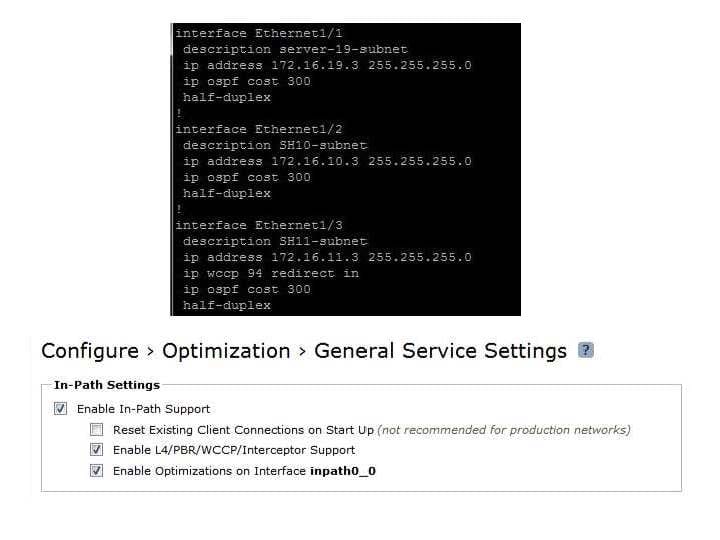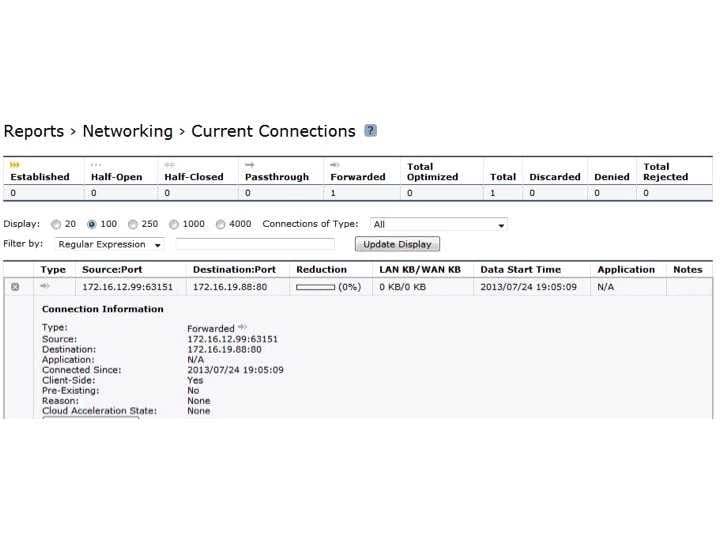Exam Details
Exam Code
:830-01Exam Name
:RCPE Certified Professional WAN OptimizationCertification
:Riverbed CertificationsVendor
:RiverbedTotal Questions
:402 Q&AsLast Updated
:Apr 13, 2025
Riverbed Riverbed Certifications 830-01 Questions & Answers
-
Question 101:
-- Exhibit

-- Exhibit -Refer to the exhibit. In a WCCP environment with R3, SH10 and SH11, it was observed that the returning traffic from Server2 is not being optimized by the Steelhead appliances. Why? (Select 2)
A. The router is not properly configured.
B. Physical in-path mode should be enabled.
C. The wccp redirect command is missing.
D. You should disable logical in-path.
-
Question 102:
SH10 and SH11 are connection forwarding neighbors. After a configuration change on SH11, SH10 is in "degraded" status. What is the possible cause? (Select 2)
A. The optimization services on SH11 are not running.
B. The connection forwarding keepalive cable was disconnected.
C. The optimization services on SH10 are not running.
D. Connection forwarding is disabled on SH11.
-
Question 103:
-- Exhibit

-- Exhibit -Refer to the exhibit. In a WCCP environment with R3, SH10 and SH11, the following screenshot shows that the load is not being distributed evenly in between the Steelhead appliances. Why?
A. They are different Steelhead appliances models.
B. One of the Steelhead appliances currently has a lower number of TCP connections available.
C. The weight setting is being used on the WCCP configuration.
D. One of the Steelhead appliances is in admission control.
-
Question 104:
-- Exhibit

-- Exhibit -Refer to the exhibit. The connection from USER1, going to SERVER2 is not being optimized by SH10.
What is the possible cause? (Select 2)
A. The connection was forwarded to another Steelhead.
B. This connection was pass through.
C. Connection forwarding is working.
D. This connection was never established.
-
Question 105:
The Xbridge feature on Interceptor provides:
A. Significant line-throughput improvement for optimized and pass-through traffic for 10 Gbps interfaces.
B. Significant line-throughput improvement for optimized traffic for 10 Gbps interfaces.
C. Significant line-throughput improvement for optimized traffic for 10 Gbps and 1 Gbps interfaces.
D. Significant line-throughput improvement for optimized and pass-through traffic for 1 Gbps interfaces.
-
Question 106:
How do you clear the peer affinity information from an Interceptor?
A. Issue the clear affinity command
B. Restart the service
C. Clear the fair peering flag
D. Pause the Interceptor
-
Question 107:
The fair peering feature on Interceptor appliances can be enabled:
A. For each load-balancing rule, including the default rule.
B. For each load-balancing rule, excluding the default rule.
C. Only for the default rule.
D. For each load-balancing rule and in-path rule
E. For each load-balancing rule, in-path rule, including the default rule.
-
Question 108:
What action is taken by the Interceptor if a connection does not match a configured load balance rule and the default pool is empty?
A. The connection is forwarded for auto-discovery.
B. The connection is passed-through.
C. The connection is rejected.
D. The connection is reset.
-
Question 109:
When deploying failover Interceptors, all in-path interfaces must:
A. be deployed on different physical links.
B. be deployed on 802.1Q trunks.
C. be deployed on all the same physical links.
D. be deployed separately.
-
Question 110:
When deploying Interceptor appliances in a parallel cluster what feature must be disabled to ensure packet redirection upon failure?
A. Fail-to-wire.
B. Connection forwarding.
C. Fail-to-block.
D. Link State Propagation.
E. WCCP.
Related Exams:
101-01
Riverbed Certified Solutions Associate201-01
Riverbed Certified Solutions Associate - Network Performance Management299-01
Riverbed Certified Solutions Professional - Network Performance Management499-01
Riverbed Certified Solutions Professional - Application Performance Management501-01
Riverbed Certified Solutions Associate - Hyper-converged Branch599-01
Riverbed Certified Solutions Professional - Storage Delivery Exam810-01
RCPE Certified Professional Network & Infrastructure Visibility830-01
RCPE Certified Professional WAN Optimization
Tips on How to Prepare for the Exams
Nowadays, the certification exams become more and more important and required by more and more enterprises when applying for a job. But how to prepare for the exam effectively? How to prepare for the exam in a short time with less efforts? How to get a ideal result and how to find the most reliable resources? Here on Vcedump.com, you will find all the answers. Vcedump.com provide not only Riverbed exam questions, answers and explanations but also complete assistance on your exam preparation and certification application. If you are confused on your 830-01 exam preparations and Riverbed certification application, do not hesitate to visit our Vcedump.com to find your solutions here.